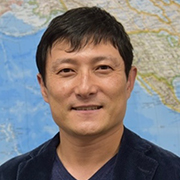A .gov website belongs to an official government organization in the United States.
A lock () or https:// means you've safely connected to the .gov website. Share sensitive information only on official, secure websites.

Following Greenhouse gases Observing SATellite (GOSAT) and GOSAT-2, the Global Observing SATellite for Greenhouse gases and Water cycle (GOSAT-GW) is now planned to be launched in 2024, as part of the GOSAT-series greenhouse gas observing satellites. The GOSAT-GW satellite will make the first global, space-based observations of the atmospheric carbon dioxide (CO2), methane (CH4) and nitrogen dioxide (NO2) in the Earth's atmosphere at a horizontal/spatial resolution of 1–3 km by the single satellite platform. It will carry two sensors, one of which is a high-resolution grating spectrometer designed to measure reflected sunlight in the 0.45-um NO2 band, the 0.76-um O2 A-band and the CO2 band at 1.61 um from visible to short-wave infrared wavelength regions to retrieve the column-averaged CO2 and CH4 dry air mole fraction (XCO2 and XCH4, respectively) and vertical column density of tropospheric NO2. The satellite will fly in a 13:30 sun-synchronous orbit with a 3-day ground-track repeat time, achieving a global coverage within 3 days. The objectives of the GOSAT-GW's GHG observing mission include (1) monitoring of whole atmosphere global-mean concentrations of GHGs, (2) verification of national (or country-specific) anthropogenic emissions inventory of GHGs, and (3) detection of GHGs emissions from large emission sources, such as megacities, power plants, and permafrost. A comprehensive validation exercise will be made to ensure that the products' quality meets with the precision needed to quantify the GHG sources and sinks on regional- to national/city-scales, and identify the anthropogenic emissions from large point sources. With a nominal lifetime of 7 years, the GOSAT-GW will provide space-based constraints on the anthropogenic GHG emissions, contributing to the mitigation of climate change, in particular, supporting the Global Stocktake (GST) mechanism, a key element in the Paris Agreement. We will provide an overview and the latest updates of the mission/project with some recent research highlights.
Hiroshi Tanimoto is the Deputy Directory of the Earth System at the National Institute for Environmental Studies (NIES) in Tsukuba, Japan. He is also the Head of Global Atmospheric Chemistry Section at NIES. Currently, Hiroshi is also the Science and Application Lead for the GOSAT-GW Project.
Hiroshi received his PhD in Chemistry from The University of Tokyo in 2001. He has been working in the field of atmospheric composition in the Asia and Oceania regions. His group develop techniques for measuring and modelling trace gases and aerosols of atmospheric importance, make laboratory experiments to reveal the formation and reaction mechanisms, observe spatial and temporal variations using ground-based, ship, aircraft, and satellite platforms, and simulated emissions, transport, transformation, and deposition processes.
Dr. Tanimoto plays a key role in all international, Asian, and Japan's scientific communities. He has served for the International Global Atmospheric Chemistry (IGAC) project as an SSC member through 2012-2016, and then as the co-chair through 2017-2020
ALL Seminar attendees agree not to cite, quote, copy, or distribute material presented without the explicit written consent of the seminar presenter. Any opinions expressed in this seminar are those of the speaker alone and do not necessarily reflect the opinions of NOAA or CSL.